Contents of Summer 2007 Collaborative Solutions Newsletter:
In this issue:
Assessing Our Progress & Celebrating Our
Success
Why
does documentation and evaluation matter in collaborative solutions?
What
kinds of questions can an evaluation help answer?
Community-based
participatory evaluation
A framework
for evaluation of coalitions
Community
Story: a neighborhood organization
Levels
of coalition assessment - tool
Community
Story: national organization with multiple sites
Coalition
Member Assessment - tool
Community
Story: a small non-profit and two communities
Tools
and Resources
Highlights from Tom Wolff & Associates
Assessing Our Progress & Celebrating
Our Success
Why does documentation and evaluation matter in collaborative
solutions?
The
question, how we are doing? often comes up in community work involving
collaborative solutions. Sometimes a coalition’s funders expect
formal evaluations. At other times the question arises when a member
says, “Well,
we have been meeting for months [or years] and what have we accomplished?
Is the community any better off?”
We do often
think that funders are the driving force that impels us to evaluate
our coalition progress. However, if we look carefully we often discover that
our members (especially our grassroots members) are often involved in a regular
evaluation process. They vote with their feet by attending or dropping out
of our community efforts. They participate when they perceive that the coalition
is succeeding at creating change.
Most collaborations
are motivated to engage in an evaluation process because it is required
for their funding. Someone on the outside has decided for them that evaluation
is a necessity. Yet successful evaluations most often occur when the
collaboration itself decides that there are critical questions that must be
answered, such as: After having been at this for three years, are we getting
anything done? Are we being effective? Is the way that we are set up the most
effective? What do all of our members think about what we are doing? These
kinds of questions can motivate a collaboration’s steering committee
and staff to undertake an evaluation process with a high level of interest.
Assessing
our progress and knowing whether we are succeeding is vitally important
to all of us. Yet we know that in most collaborative solution processes very
little evaluation or assessment occurs (Cashman and Berkowitz, 2000). Coalitions
may fail to evaluate their efforts for several reasons: (1) They lack motivation
and interest; (2) They lack access to easy, usable tools for evaluating
both the process and the outcome of the collaborative efforts; (3) They fear
what evaluators might "find"; or (4) They fail to find appropriate
evaluators and set up effective, mutually respectful relationships
with them--relationships in which the data collected are actually useful.
So
why do collaborations become engaged in evaluations? There are some
clear motivations: (1) They want to improve their work and getting
feedback is one proven way to accomplish that; (2) They want to record
and celebrate their successes; (3) They must report on their progress
to a funder, a board, or the community; (4) They are thinking of their
future and issues of sustainability, and a first step in ensuring ongoing
viability is assessment that tells the group which activities to continue
and which to jettison ( http://www.tomwolff.com/collaborative-solutions-newsletter-inaugural-issue.html).
(CADCA, 2006 see Resources).
Page Top
What kinds of questions can an evaluation help answer?
What
activities took place? A process evaluation focuses
on day-to-day activities. Methodologies include activity logs,
surveys, and interviews. Materials to track can include in-house
developments, outside meetings, communications received, community
participation, and media coverage. Surveys can rate the importance
and feasibility of goals and the satisfaction of members. Process
evaluation can also analyze critical events in the development of the
collaboration. Process evaluation helps a coalition see the
strengths and weaknesses of its basic structure and functions.
What was accomplished? An outcome evaluation focuses
on accomplishments. It can include changes in the community
(the number and type of shifts in policies or practices) as
well as the development of new services. It can also involve surveys
of self-reported behavior changes, rating the significance of outcomes
achieved. The number of objectives met over time is a useful evaluation
tool.
What were the long-term effects? An impact evaluation focuses
on the ultimate impacts that the collaboration is having on the community,
over and above specific outcomes. The focus here is on statistical
indicators of population-level outcomes. For example, a teen pregnancy
collaboration might focus on the pregnancy rate for its community.
Page Top
Community-based participatory evaluation
Once
the results have been collected and reports written, the collaboration
must actively disseminate the findings to the community so that its
members can look at the data, decide what changes are necessary in
response to the findings, and change or adapt the strategic plan
and the collaboration’s activities in response to the results
found in the evaluation.
In
order to satisfy the coalition’s interests, the evaluations
must be both methodologically sound and intimately involved with the
organization. Too often our evaluation processes and instruments are
developed and implemented by outside evaluators. Coalition members
only see the information many months or even years after it is collected,
when final reports are prepared for the funder.
In
collaborative solutions processes, we strongly advocate for close working
relationships between the evaluators, the coalition staff, and the
community. You cannot learn from evaluation results that are not fed
back to you regularly. Nor can you celebrate successes in a timely
manner. You cannot develop a sustainability plan unless all coalition
members have access to evaluation information. So when we work in collaborative
situation we not only have to develop appropriate evaluation mechanisms,
we have to develop whole new ways for the community to engage in the
process.
Page Top
A
framework for evaluation of coalitions
Evaluation of coalitions is complex. The field and the literature
are evolving and new research documentation systems and tools emerge
on a regular basis. There are questions about what to measure and how
to measure the process and the various levels of outcomes (Wolff, T.
A Practical Approach to Evaluating Coalitions http://www.tomwolff.com/resources/backer.pdf)
One of the best models for evaluating coalitions comes from the Work
Group for Community Health and Development at the University of Kansas
(http://communityhealth.ku.edu/).
Based on the Institute of Medicine’s framework for collaborative
public health action in communities (2003), this evaluation model is
described below. It’s easy to see that this model would apply
not just to the coalition-building work of organizations but also to
other systems-change agendas.
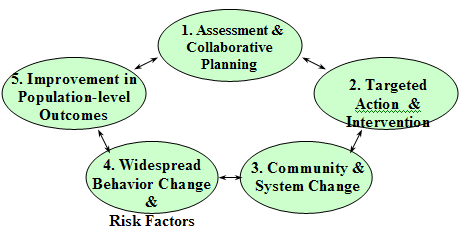
A framework for collaborative public health
action in communities.
(Source: CDC, 2002; Fawcett et al., 2000; Institute
of Medicine, National Academy of Sciences, 2003.)
The
model for participatory evaluation developed by Fawcett and
Schultz (2007) is made easier through customized Internet-based
Workstations that include online supports for documenting and
analyzing accomplishments, graphing, and reporting (Fawcett
et al, 2003). It provides clear pathways for understanding the
change processes involved in collaborative solutions, and therefore
for understanding the evaluation questions that follow. In most
efforts that involve collaborative solutions, we are working
with multiple factors that produce multiple and interrelated
outcomes. No single intervention--no one program or policy change
targeting one behavior--is likely to improve population-level
outcomes. Often there are long time delays between a collaborative’s
actions and the resulting widespread behavior change. So it
is difficult to assess whether any effort, or combination of
efforts, is bringing about change. And of course the most important
thing we want to know is whether our efforts are producing change.
With the KU Work Group’s participatory evaluation model (Fawcett, et al.,
1995; 2000; 2003; 2004), groups document new programs, policies, and practices,
along with the community and systems changes that are the critical components
of the coalition effort. Programs, policies, and practices—changes
in communities and systems-- are central to this model. If we think about
it, these three really do capture the intermediary changes that most of us see
along the path to community change. Say we are looking to reduce the level of
smoking in a given community. Before we can measure the population-level reduction
in smoking, we can document that we've put smoking-cessation classes in place,
smoking-prevention programs in the schools, policies on smoking cessation in
workplaces, and policies to ban smoking in restaurants. We can also document
changes in smoking behavior (practices) in multiple settings (schools, work,
entertainment). Documentation of these types give us an excellent intermediary
way to measure a coalition’s success long before we can document the change
in smoking levels in the community as a whole.
The KU Work Group’s participatory
evaluation framework (Fawcett et al., 2004; Institute of Medicine, 2003),
detailed below, proposes a general model with evaluation questions
related to the five phases of the IOM model.
Overall question: Is the initiative serving as
a catalyst for change related to the specific goals?
Evaluation questions at each of the five phases are:
- Assessment and collaborative planning
- How has the coalition developed its organizational capacity?
- Does the coalition have a vision and a plan for community mobilization?
- Is the coalition membership inclusive of all community sectors?
- Targeted action intervention
- Has the coalition developed measurable and targeted action steps?
- Is the coalition taking actions to reach its goals?
- Will these action steps help the coalition reach its goals and meet its objectives?
- Community and systems change
- Does the coalition create community changes, defined as changes in programs,
policies, and practices?
- Have participating organizations changed programs, policies,
and practices? (These are the intermediary outcomes
that seem to be able to predict the ultimate population-level
change).
- Widespread behavior change
- How widespread is the change?
- Where have these changes occurred and what form do they take?
- Are changes happening in many sectors and systems?
- Improvement in population-level outcomes
- How are community/system changes contributing to the efforts to improve
the community?
- Are community/system changes associated with improvements in population-level
outcomes?
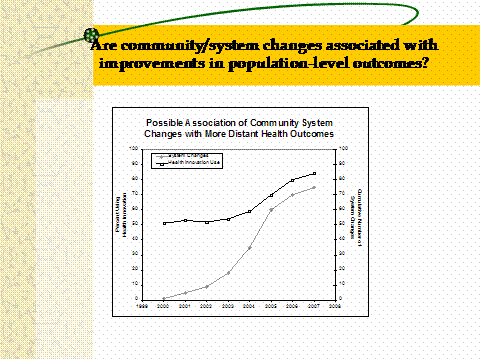
The chart above plots out both community changes (policies, practices,
programs)
and population-level outcomes. The relationship of the curve changes
for these
measures is one way of getting attribution.
Although this model was especially
developed around health issues, it generalizes quite well to most
types of community change (see Fawcett et al, 2004). Thus, an ultimate
population-level outcome may be the level of smoking in a community
and level of smoking-related illness (for a health-related concern)
or it may be the level of violence, or the level of access to adult
basic education for immigrants (for social concerns).
Page Top
Community Story: A
Neighborhood Organization, Documentation/Evaluation
The
best way to show you what we mean is to tell you about some of the work we
do with coalitions and communities. We get called upon to conduct or assist
with evaluations in many ways. On the most basic level, we work with grassroots
neighborhood groups who need to track their successes for themselves and
their stakeholders. On a larger scale, we are contracted to evaluate national
coalition-building programs with numerous sites across the country. In both
cases, the core question is what information will help the coalition grow
and be able to demonstrate its accomplishments to its members and its stakeholders.
With the
Cleghorn Neighborhood Center (CNC) in Fitchburg, Massachusetts, we helped them
shift their mission and work from a service framework back to its roots in
community development and community organizing. It received funding from the
Community Foundation of North Central Massachusetts and a green light from
its board for this shift. Following this change, both the coalition and the
foundation needed to see whether the new plan was really going to work. Because
little community development work was occurring in the neighborhood, how to
asses the new approach was a mystery for many in the area. Community development
was also new territory for the staff, so we designed a documentation process
that would help the staff stay on track at the same time as they recorded
their progress.
We adapted the University of Kansas’ Online Documentation
and Support System (for information on purchasing these services go
to the KU Work Group’s website: http://communityhealth.ku.edu/services/services.shtml/ ).
This is based on the Ku Work Group’s efforts to provide
the grassroots group with a low-cost/no-cost tracking system. The staff
defined and logged activities, recorded number of people involved,
and tracked resources generated, planning products, services provided,
community actions by staff and residents, and community changes. (See
definitions below). As a result of these records, CNC was able to provide
charts and commentary in its report to its funder and its board .
Below
is an example from a CNC report/grant application:
The CNC used the Kansas Documentation System as a tool
to document and evaluate its community development activities. This
tool has been used by such organizations as the Centers for Disease
Control, the MacArthur Foundation, and the Kansas Health Foundation.
Log – All community development activities were tracked by
entries in a comprehensive log. Ninety-four activities were documented
by the CNC during the past year. The log entries provide a view of
both activities and community response.
Documentation system – This system was used to track community
changes that were created by community coalitions and community development
activities. The logged data and other information tracked the progress
of the initiative in relation to the following variables, which are
defined below:
Community Actions--Residents: Activities aimed at community
change completed by the volunteer group outside of CNC.
Community Actions--Staff: Activities aimed at community change
completed by CNC staff.
Resources Generated: New services, funds, or materials generated by
resident volunteers
and staff.
Services Provided: Activities by the resident volunteers that occur
in the CNC.
Planning Products: Creation of task forces, mini-grant applications,
recruitment, PEP, etc.
Community Change: Policy, practices and procedures (PPP) in the community
that assist the CNC in reaching community changes (i.e. cleaner neighborhood)
Increases in community activities and community changes continue
to be most critical to CNC’s efforts. The tables below indicate
the greatest increase in three major areas--planning products, resources
generated, and community actions--residents. There is a steady, but
lesser, increase in community actions--staff, services provided,
and community changes. The table reflects that during the first six
months of the project, internal capacity was built by hiring staff,
reaching out to the community, and structuring next steps. The progress
increased in June after the community meeting where volunteer groups
came together to address community issues.
Total Community Progress
Chart
1
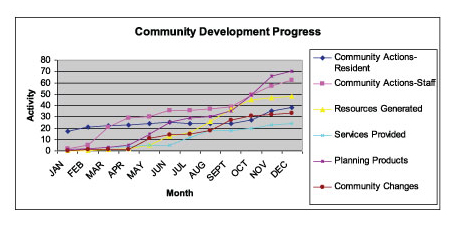
Charts broken down by category
Chart 2
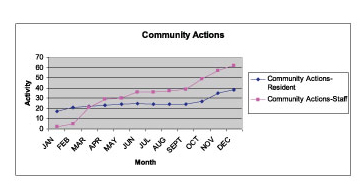
Community Actions--Residents – The most frequent activities
measured were actions by community residents. Examples of this category were:
resident-led street clean ups, bi-weekly resident meetings, GED and PEP classes,
and International Food Night. This illustrates that mobilization efforts
were very effective, resulting in residents increasingly acting to improve
their neighborhood.
Community Actions--Staff – The graph reflects the role of staff
as catalysts, with community residents’ roles as leaders. The high level
of residents’ activities has been a positive challenge to the staff.
Chart
3
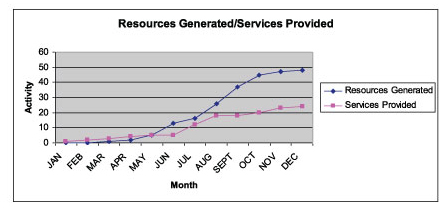
Resources Generated – Reflected in this graph is the level of
new, local resources that were raised as a match to Community Foundation’s
funding. Examples included residents:
- Donating time as skilled computer technicians to fix equipment
- Writing newspaper articles on the neighborhood changes and the newsletter
- Earning funds to supplement staff and program salaries
- Assisting with building maintenance
- Fundraising on behalf of the center to supplement programming expenses
Services Provided – Traditionally, these would have incorporated
the CNC’s food pantry, clothes closet, and translation services. However,
thanks to the efforts of the community development process, new services have
emerged, which include:
- Residents meetings
- Yard sales that are coordinated by residents
- Thanksgiving donations
The above services originated in the CNC and were identified by the resident
volunteers.
Chart
4
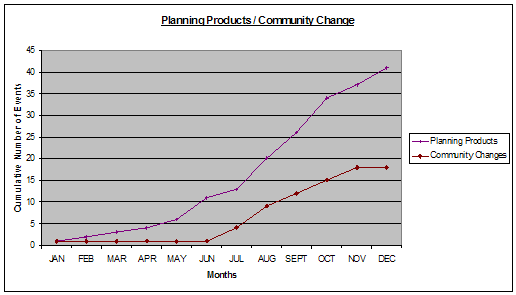
Planning Products – The graph shows the development of appropriate
planning products to move the community development process along. These included
the creation of resident working groups, such as the Parent Initiative, the
Traffic Safety group, and the Community Activity groups. It also included staff
and consultant ongoing planning.
Community Change – This graph shows that community changes have
occurred as an outcome of community actions. Below are examples of new community
changes that have resulted from the CNC community development process:
- Cleghorn is cleaner
- Relationships with residents (CNC to Resident and Resident to Resident)
have been built
- The CNC has been successful in advocating for residents (discrimination
issue)
- There is more police presence in the neighborhood
- More first-time voters are registered
- Residents of different ethnicities have been brought together in celebration
Although this project is still in its infancy, the successes to date have laid
the foundation for continued growth. The Cleghorn neighborhood and the residents
involved with the Cleghorn Neighborhood Center are becoming a catalyst for
community change. This change will lead to a revitalization of the historic
Cleghorn Neighborhood and will simultaneously engage and empower its residents.
Ultimately, we are looking for changes in policy, practices, and procedures
in the community; an increase in Latino leadership; and a strategy to be implemented
to bring diverse people to the table.
Ref. Cleghorn Neighborhood Center Grant
Submission
Page Top
Many levels of coalition assessment
When we set out to document our collaborative solutions work, we have lots
of choices as to what we will look at and what we will measure. We can ask
mainly internal-process questions about whether the coalition has the members
and core processes that it needs. We can ask about relationships and changes
in relationships, which emerge as both process and outcome components critical
to a collaborative’s
success. Finally, we can ask about the various levels of outcomes, or end results.
A Level
of Coalition Assessment Tool has been developed that describes
the range
of questions we can choose from when we document our coalitions’ work. We
use this list to help clients decide what they want to learn about through
documentation and evaluation. In a collaborative participatory evaluation process,
the members of the coalition and the community can review these questions to
decide what is most important for them to know. This helps ensure that the
evaluation is aimed at the key needs of the coalition’s members.
Page Top
Community Story: National Organization with Multiple Sites-Documentation
and Evaluation
One example of the use of a list
of levels of assessment, like the one referenced
above, involves our work with a federal project with
17 sites covering the nation. In the last year, we were asked to evaluate the
progress of each of the 17 networks on its collaborative ventures. Our efforts
have involved a number of steps. We started with the list of questions on the
levels of assessment to help us all understand what the federal agency and
the networks wanted to assess. The evaluation ultimately included a review
of the work to date; the development and completion of oral interviews of the
17 directors and staff; and the development of an online Coalition Member Assessment
form.
Coalition Member Assessment Tool
The
Coalition Member Assessment Tool is a variation of earlier satisfaction
surveys (http://www.tomwolff.com/resources/backer.pdf -
see Gillian Kaye, Steve Fawcett instruments) that allow members
to rate their coalition on a 1-5 scale, from agree to strongly disagree.
The instrument has 44 rated questions and a few open-ended questions. It covers
the following areas:
Vision – planning,
implementation, progress
Leadership
and membership
Structure
Communication
Activities
Outcomes
Relationships
Systems
outcomes
Benefits
from participation
Open-ended
questions
The
Coalition Member Assessment lends
itself to online survey mechanisms (Survey Monkey at www.surveymonkey.com,
Zoomerang at www.zoomerang.com)
that make it easy to administer the survey and tabulate the results.
Page Top
Community Story: A Small Non-Profit and Two Communities, - Documentation
and Evaluation
Another evaluation story involves our work with a
small substance-abuse agency in upstate New York where we helped them to
track their development work in two struggling communities. This evaluation
was designed to allow the staff, which was untrained in evaluation, to conduct
the evaluation themselves and to feed back data to the community on a regular
basis. A notebook was developed that included logs of all activities undertaken
by the coalition (staff and community members), minutes from meetings, records
of meeting attendance, and copies of all community press coverage. Most coalitions
ordinarily keep this type of information, so it could easily be channeled
to produce the core data for both process and outcome evaluations.
One
of the goals of the coalition was to create leadership. The attendance and
logs were examined to document moments when community members took a leadership
role. These were charted.
The
regular logs of activity were analyzed through a system developed by the University
of Kansas (Fawcett et al 1995; 2000; 2003; 2004) to document collaborative
outcomes. The initiative documented services provided, planning products, resources
generated, community actions, and community changes. These variables were charted
in a cumulative graph.
A
format was created for evaluating all training opportunities for community
members, and finally a member-satisfaction survey and follow-up interviews
were implemented.
All
of these were pretty straightforward mechanisms. They were implemented by a
local staff person who had little background in evaluation but worked with
care and produced a highly successful notebook. The notebook provided a clear
picture of the coalition’s activities and successes. As the data emerged,
it was regularly shared with coalition members at their monthly meetings. The
community participants found the information useful and the completed notebook
provided impressive coverage of the coalition’s activities for the large
foundation that was supporting its work.
This project
offers a wonderful example of how a consultant can build the client’s
evaluation capacity instead of doing the evaluation. One advantage of this
approach is that evaluation can be easily integrated into the coalition’s
daily work—both gathering information and immediate use of the findings.
In this case, the staff person regularly shared evaluation information with
members as it emerged. Another advantage is that the sponsoring organization
ends up with a staff person who has new evaluation skills.
Page Top
Conclusion
We hope
that this issue of the Collaborative Solutions Newsletter will help our readers
feel more comfortable and less intimidated with the idea of assessing progress
and celebrating successes. We hope to help coalitions feel that they are able
to proceed with documentation and evaluation of their collaborative efforts
on their own.
Documentation
and evaluation are important. They allow you to understand where your coalition
is going; what your members feel about the direction; and whether, indeed,
you're making a difference.
Documentation
and evaluation of collaborative efforts is understandable and do-able. It does
not have to be a mystery. It does not have to call up old math anxiety. It
can simply involve asking the key people the key questions.
Documentation
and evaluation can help your coalition answer critical questions about your
efforts. Are you all clear on where you are headed? Do you have a viable structure?
What changes are you really creating? Is your progress steady?
Documentation and evaluation, when done in a participatory manner so that the
coalition and not the evaluator is in charge, will help your coalition grow.
Page Top
References:
CDC (Centers for Disease Control and Prevention). (2002). Syndemics overview:
What procedures are available for planning and evaluating initiatives to prevent
syndemics? The National Center for Chronic Disease Prevention and Health Promotion
Syndemics Prevention Network. Available online at www.cdc.gov/syndemics/overview-planeval.htm.
Accessed June 13, 2007.
Fawcett, S.B., Francisco, V.T., and Schultz, V.T. (2004). Understanding and improving
the work of community health and development. In J. Burgos and E. Ribes (Eds.),
Theory, basic, and applied research and technological applications in behavior
science. Guadalajara, Mexico: Universidad de Guadalajara.
Fawcett, S. B., Francisco, V. T., Hyra, D., Paine-Andrews, A., Schultz, J. A.,
Russos, S., Fisher, J. L., and Evensen, P. (2000). Building healthy communities.
In A. Tarlov and R. St. Peter (Eds.), The society and population health reader:
A state and community perspective (pp. 75-93). New York: The New Press.
Fawcett, S.B., Schultz, J.A., Carson, V. L., Renault, V.A., and Francisco, V.T.
Using Internet based tools to build capacity for community-based participatory
research and other efforts to promote community health and development. In M.
Minkler and N. Wallerstein (Eds.), Community based participatory research for
health (pp. 155-178). San Francisco: Jossey Bass.
Fawcett, S. B., Sterling, T. D., Paine-Andrews, A., Harris, K. J., Francisco,
V. T., Richter, K. P., Lewis, R. K., and Schmid, T. L. (1995). Evaluating
community efforts to prevent cardiovascular diseases. Atlanta, GA: Centers
for Disease Control and Prevention, National Center for Chronic Disease Prevention
and Health Promotion.
Institute of Medicine. (2003). The community. In The future of the public’s
health in the 21st century (pp. 178-211). Washington, DC: National Academies
Press.
Page Top
Tools and Resources:
How to
purchase participatory evaluation services and online supports from the
University of Kansas Work Group for Community Health and Development: The
KU Work Group can build and provide technical support for a customized Online
Documentation and Support System for your initiative (Link
to below and link to KU Work Group’s website http://communityhealth.ku.edu/services/services.shtml/
Building Healthy Communities – Lessons and Challenges,
Berkowitz ,B.& Cashman,S, Community 3(2), 1-7 2000
CADCA Report Drug-Free Communities Support Program
National Evaluation.– 2006 National Evaluation of DFC (Drug
Free Communities) Program Shows Successful Coalitions Exhibit Similar Characteristics
National Coalition Institute Research into Action April1,2007 Office of National
Drug Control Policy. (2007). Annual findings report 2006: Drug-Free Communities
Support Program National Evaluation. Battelle & the Association for
the Study and Development of Community. Click
here to download the 2006 Annual Findings Report.: http://www.whitehousedrugpolicy.gov/dfc/evaluation.html
Monitoring and Evaluation of Coalition Activities and Success by
Stephen Fawcett, David Foster, and Vincent Francisco. Chapter in From
the Ground Up: A Workbook on Coalition Building and
Community Development by Tom Wolff and Gillian Kaye.
1994 http://www.tomwolff.com/healthy-communities-tools-and-resources.html
A practical approach to evaluating coalitions. Tom Wolff
in Backer,T. (Ed.)
Evaluating
Community Collaborations. Springer Publishing, p57-112, 2003.
Studying the Outcomes of Community-Based Coalitions, Berkowitz,
Bill
In The Future of Community Coalition Building American Journal of Community
Psychology Vol. 29, no.2, 213-228, 2001
Page Top
Highlights of recent work by Tom Wolff & Associates
The last six months have been an especially productive and busy time
for Tom Wolff & Associates. We are delighted to have been engaged
in exciting work with numerous organizations at local, state, and national
levels.Some highlights are noted below:
Boston College: Building community – university relationships
to increase capacity regarding substance-abuse prevention.
Boston’s REACH 2010 program: Disparities in breast and cervical
cancer among Black women. Ongoing consultation and training focused
on sustainability.
Centers for Medicare and Medicaid Services: Ongoing support to the
Strategic Partnership for Change coalition building efforts of the
End Stage Renal Disease Networks within CMS. Consultation, training
and program evaluation.
Cleghorn Neighborhood Center: Ongoing consultation to grassroots neighborhood
organization.
Enlace, Holyoke: Building the Next Generation of Latino Leadership
in Holyoke.
Coordinating all existing community coalitions for the benefit of the
community.
First National Conference for Caregiving Coalitions--Creating
a Legacy: Sustaining Your Efforts, March 2007, Chicago, IL.
Healthy Wisconsin Leadership Institute--Creating a Legacy: Sustaining
Your Efforts, April 2007, Madison, WI.
Highland Valley Elder Services: Consultation--building community assets
in elder communities and elder housing.
Kansas Health Foundation 2007 Recognition Grant Conference: Collaborative
Solutions for Communities. What do we think and know about Collaboration?
April 2007, Wichita, KS.
Society for Community Research and Action: Creating and planning the
First Community Psychology Practice Summit.
Wyoming Tobacco Coalitions: Building and Sustaining Wyoming’s
Tobacco Coalitions, April 2007, Casper, WY.
